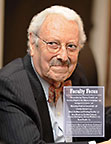Anatomy of a Financial Meltdown
Printer Friendly Version A scholar of financial institutions, Geoffrey Miller, Stuyvesant Comfort Professor of Law and director of the Center for the Study of Central Banks and Financial Institutions, naturally wanted to investigate the origins of the current global economic recession. Miller thought law students might share his interest, so he created The Crisis of 2008 seminar. “Registration closed in about 20 minutes,” Miller said. “There is a tremendous demand for knowledge about how this crisis happened.”
A scholar of financial institutions, Geoffrey Miller, Stuyvesant Comfort Professor of Law and director of the Center for the Study of Central Banks and Financial Institutions, naturally wanted to investigate the origins of the current global economic recession. Miller thought law students might share his interest, so he created The Crisis of 2008 seminar. “Registration closed in about 20 minutes,” Miller said. “There is a tremendous demand for knowledge about how this crisis happened.”
Miller came to the conclusion that the crisis was foreseeable. He likens the current global recession to the Challenger disaster of 1986, in which the space shuttle exploded shortly after takeoff due to faulty seals on the booster engines. “The design flaw made what happened inevitable, but no one saw it at the time,” he said. “In this case, the challenge for law- and policy-makers who did not predict what would inevitably happen is how to take effective action to deal with the disaster and prevent further economic disasters in the future.”
In response to the overwhelming interest in the course, Miller made the unusual but welcome decision to open up the first three sessions to the Law School community. These three-hour classes in January each focused on a particular aspect of the crisis. The first class examined prior financial crises to gain historical background and appreciation for the scope of the disaster. The second, co-taught with Gerald Rosenfeld, co-director of the Mitchell Jacobson Leadership Program in Law and Business, looked at the “subprime mortgage mess” of 2007: how it happened, what could have prevented it, and its consequences on the global economy. The third class, also with Rosenfeld, looked into the credit crunch of 2008 and the “dramatic events that followed,” including the near-failure of Bear Stearns, the bankruptcy of Lehman Brothers, and the scramble for survival among large multinational companies like Citicorp, AIG, and General Motors.
After the first three open classes, the course became a seminar for the 28 registered students, who delved deeper into the course materials and conducted research and wrote papers on such topics as housing finance, banks, credit markets, insurance and securities, the effect of the crisis on Main Street, and the international dimensions of the crisis.
Miller said one of the biggest challenges in creating this course was compiling materials on what he called “a moving target.” Relying heavily on news accounts and government statistics, “I had to make it up out of whole cloth,” he said. The classes made extensive use of multimedia materials, including news items in audio and visual formats and hundreds of PowerPoint slides created by Miller. But the effort was worth it: “This is the most significant economic downturn since the Great Depression,” Miller said. “Fundamental damage has been done to the credit and securities markets. We face a very long recovery from the big bubble bursting. It is not going to be fast. We are all going to be living with this for a long time.”
–
All of 2009 Faculty Focus

 Multimedia
Multimedia